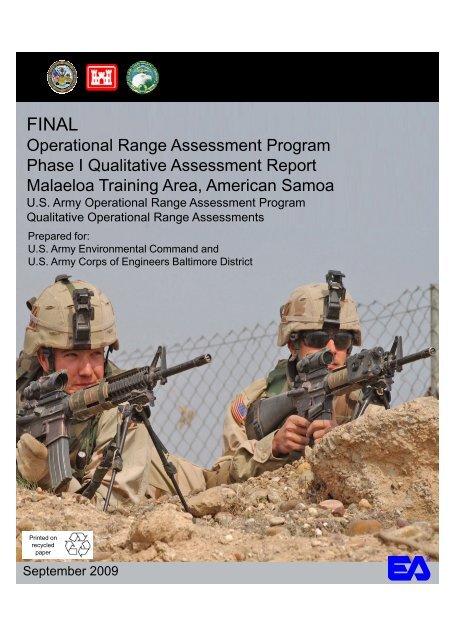Operational Range Assessment Progra Phase I Qualitative ...
Operational Range Assessment Progra Phase I Qualitative ...
Operational Range Assessment Progra Phase I Qualitative ...
You also want an ePaper? Increase the reach of your titles
YUMPU automatically turns print PDFs into web optimized ePapers that Google loves.
FINALOPERATIONAL RANGE ASSESSMENT PROGRAMPHASE I QUALITATIVE ASSESSMENT REPORTMALAELOA TRAINING AREAAMERICAN SAMOASEPTEMBER 2009Prepared for:UNITED STATES ARMY CORPS OF ENGINEERS, BALTIMORE DISTRICTP.O. Box 1715Baltimore, Maryland 21203andUNITED STATES ARMY ENVIRONMENTAL COMMANDAberdeen Proving Ground, Maryland 21010Prepared by:EA ENGINEERING, SCIENCE, AND TECHNOLOGY, INC.15 Loveton CircleSparks, Maryland 21152
<strong>Operational</strong> <strong>Range</strong> <strong>Assessment</strong> <strong>Progra</strong>m, <strong>Phase</strong> I <strong>Qualitative</strong> <strong>Assessment</strong> Report September 2009Malaeloa Training Area, American SamoaEXECUTIVE SUMMARYThe United States (U.S.) Army is conducting qualitative assessments at operational ranges to meet therequirements of Department of Defense policy and to support the U.S. Army Sustainable <strong>Range</strong><strong>Progra</strong>m. The operational range qualitative assessment (hereinafter referred to as <strong>Phase</strong> I<strong>Assessment</strong>) is the first phase of the U.S. Army <strong>Operational</strong> <strong>Range</strong> <strong>Assessment</strong> <strong>Progra</strong>m (ORAP).This <strong>Phase</strong> I <strong>Assessment</strong> evaluates the operational range area at Malaeloa Training Area (TA) toassess whether further investigation is needed to determine if potential munitions constituents ofconcern (MCOC) are or could be migrating off-range at levels that may pose an unacceptable risk tohuman health or the environment. In conducting the <strong>Phase</strong> I <strong>Assessment</strong>, MCOC sources, potentialoff-range migration pathways, and potential off-range human and ecological receptors are evaluatedas appropriate.Presently the Sergeant First Class Pele United States Armed Forces Reserve Center (SFC PeleUSAFRC) in American Samoa is comprised of the U.S. Army Reserve Training Center in Tafuna andthe Malaeloa TA, formerly referred to as the American Samoa Local Training Area (LTA). MalaeloaTA encompasses 78.7 acres of land located northwest of the Village of Malaeloa on the westside ofthe Malaeloa Valley. The village of Malaeloa is located approximately four miles west of the SFCPele USAFRC and the Pago Pago International Airport and approximately seven miles southwest ofPago Pago, the capital city of American Samoa. The training area consists of a single operationalrange: a light maneuver training area. Historically a 25-meter small arms range, located in the centerof the training area, was used for approximately one year, but has remained inactive since 1999.There is no non-operational use area at Malaeloa TA (Army <strong>Range</strong> Inventory Database-Geodatabase,2008).Malaeloa TA is leased from a private citizen of American Samoa under temporary lease agreementsthat recently expired in September 2008 and has been used sporadically since 1988 by the U.S. ArmyReserve. The SFC Pele USAFRC in American Samoa is presently re-negotiating lease agreements tocontinue use of the Malaeloa TA in the future.Potential MCOC sources identified at Malaeloa TA consist of the impact berm for the historical25-meter small arms firing range. In general, MCOC from primary source areas potentially impactsoil. Although military munitions have been used at Malaeloa TA, the migration of on-range MCOCto off-range receptors is unlikely. Physical factors such as topography, vegetation, and soils limit thepotential for potential MCOC to migrate off-range at levels which may negatively impact humanhealth or the environment. Existing sampling analysis confirms that potential MCOC migration islimited, even within the historical small arms range. The single operational range at Malaeloa TA iscategorized as Unlikely.Unlikely – Five-Year ReviewThe single operational range at Malaeloa TA, totaling 78.7 acres, is categorized as Unlikely. Basedupon a review of readily available information, ranges where there is sufficient evidence to show thatthere are no known releases or source-receptor interactions off-range that could present anunacceptable risk to human health or the environment are categorized as Unlikely. <strong>Range</strong>scategorized as Unlikely are required to be re-evaluated at least every five years. Re-evaluation mayoccur sooner if significant changes (e.g., change in range operations or site conditions, regulatorychanges) occur that affect determinations made during this <strong>Phase</strong> I <strong>Assessment</strong>.Table ES-1 summarizes the <strong>Phase</strong> I <strong>Assessment</strong> findings.EA Engineering, Science, and Technology, Inc.ES-1
















